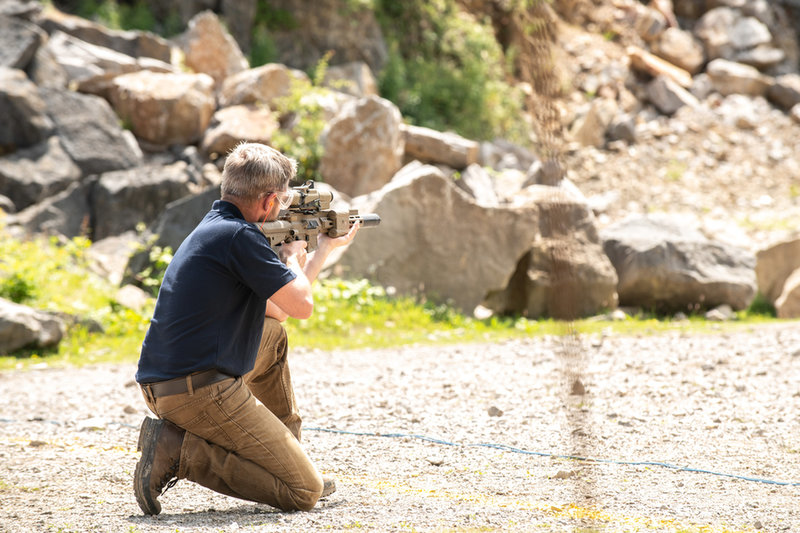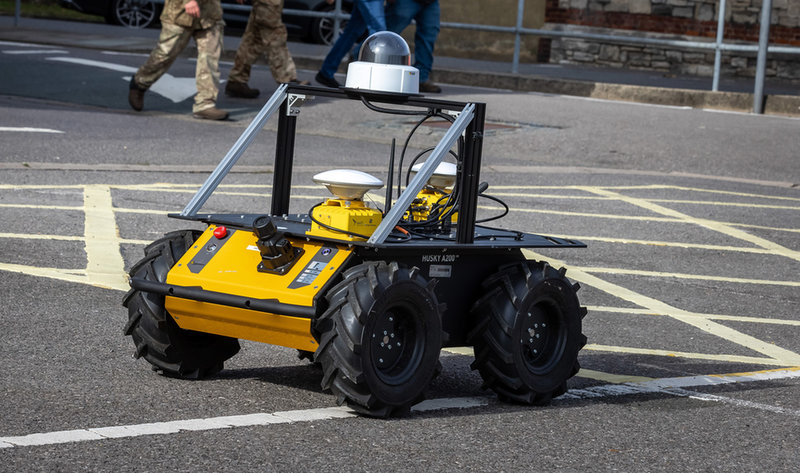The science inside: Dstl’s 2021 innovation highlights
In response to last year’s Integrated Review, the UK Defence Science and Technology Laboratory placed greater emphasis on research into artificial intelligence, autonomy, cyber, novel weapons and space. Interim chief executive Douglas Umbers gives an overview of the organisation’s 2021 achievements.
In a year when the world grappled with the disruption caused by the coronavirus pandemic, the West and its allies continued to face a multitude of threats. Not just the traditional physical threats posed by warplanes, missiles and other firepower but the increasing prominence of hybrid warfare. Cyberattacks, uncrewed air systems, electromagnetic effects, to name but a few, all pose a risk, whether to the UK armed forces and security personnel or our daily lives.
Dstl is playing its part in helping the UK and its allies stay ahead of those who wish us harm and threaten our way of life.
The Defence Science and Technology Laboratory (Dstl) exists to keep the UK’s people and its military safe from harm. Dstl’s world-class people are a proven defence asset we can be all be proud of, whether it be acting as a trusted partner to demystify and harness the application of science and technology (S&T), offering credible, impartial, evidence-driven advice and solutions to the armed forces, police and security colleagues, or helping to create clear military and security advantage.
Dstl is playing its part in helping the UK and its allies stay ahead of those who wish us harm and threaten our way of life. We are giving greater emphasis to research into artificial intelligence, autonomy, cyber, novel weapons and space in support of the ambitions outlined by the Prime Minister in the Integrated Review of Security, Defence, Development and Foreign Policy. We are also casting our net wider to find, nurture and fund generation-after-next technologies that have the potential to give the UK the edge, boosted by an additional £1bn of defence S&T research funding.
Our work spans both the traditional and newer domains from under the ocean to space, with increasing integration across multiple domains. In our review of the year here are just a few highlights.
Maritime
Intelligent Ship demonstrates how automation, autonomy, machine learning and artificial intelligence (AI) can be closely integrated and teamed with humans, enabling more timely and better-informed decision making and planning. The programme de-risks and evaluates technologies and approaches to enable revolutionary future platform, fleet and cross-domain concepts to enhance UK military advantage.
During Exercise Formidable Shield, Dstl brought AI into the command spaces on a Type 45 destroyer and Type 23 frigate for the first time. This will crucially increase engagement timelines and provide the commanders with tools to support operational decision making.
The pioneering Extra Large Uncrewed Underwater Vehicle (XLUUV) developed by MSubs is testing onboard systems, sensors and payloads required to support a range of scenarios to help develop the Royal Navy’s understanding of the utility and operational boundaries of uncrewed underwater vehicle systems.
Air
The introduction of uncrewed aerial systems (UAS) has been one of the most significant technological advances of recent years, posing an immediate threat to UK forces and resistance to available counter-UAS capability. Dstl is developing, demonstrating and evaluating viable capabilities to detect, track, identify and defeat hostile UAS across a range of defence situations.
Dstl has worked collaboratively across the Ministry of Defence (MOD), with government partners and industry towards a sovereign APP enterprise ready to deliver the Next Generation Air Survivability (NGAS) and maintain operational independence and freedom of access and manoeuvre.
Land
Working with industry partners SEA, Qioptiq and Lantac, Dstl’s Future Individual Lethality System (FILS) technology demonstrator programme delivered a next-generation prototype assault rifle with increased range, integrated data and power and a radically improved fused multispectral surveillance and target acquisition system. It is the first assault rifle capable of tasking third party effects such as remote weapon stations.
Dstl is conducting a scientific assessment of the potential use of autonomous systems for resupply operations to understand how they will integrate with the wider defence logistics capability for the army under the Joint Tactical Autonomous Resupply and Replenishment (JTARR) project. This will inform the wider Project Theseus to “define and deliver an end-to-end, highly automated ground and air resupply network, enabled by a logistic information system; 24/7 and in all conditions.”

// Dstl’s FILS technology demonstrator programme delivered a next-generation prototype assault rifle. Credit: Dstl Crown Copyright.
Multi-domain integration
Dstl scientists led the first Five Eyes nations urban military experiment in the UK, known as the Contested Urban Environment Exercise (CUE21). The experiment in Portsmouth involved demonstrating novel and emerging Intelligence, surveillance and reconnaissance technologies to enhance forces’ situational awareness when operating in complex urban-littoral environments.
Three contracts, worth around £72.5m, have been awarded to UK industry to produce advanced laser and radiofrequency demonstrators. Known collectively as directed energy weapons, these next-generation technologies could revolutionise the battlefield and reduce the risk of collateral damage. The systems are powered by electricity and operate without ammunition, significantly reducing operating costs, increasing platform endurance and providing unprecedented offensive and defensive flexibility to personnel on the frontline.

// Dstl scientists led the Contested Urban Environment Exercise, CUE21. Credit: Dstl Crown Copyright.
Cyber
Dstl is a key partner of the National Cyber Force (NCF). Set up to transform the UK’s capacity in cyber operations against the likes of terrorists, criminal gangs and hostile states, the NCF draws together personnel from GCHQ, MOD, the intelligence services and Dstl for the first time under one unified partnership and command. By working in collaboration with NCF partners and capitalising on the breadth and depth of scientific specialisms within Dstl, the team has been able to meet the needs of NCF customers and operational requirements faster than ever before.
Dstl researchers and analysts have provided expert advice on the protection from cyber-attacks of critical networks and facilities. Table-top exercises tested cyber mission assurance under the Op AUGITE directive on cyber network defence. Dstl personnel provided planning and operational support to Op FORTIS, the UK’s Carrier Strike Group 21 (CSG21) deployment, on defence from cyber-attack.
Space
Dstl’s research is supporting UK Space Command, formed in April 2021, and the government’s ambition that by 2030 the UK will have the ability to monitor, protect and defend our interests in and through space, using a mixture of national capabilities and burden-sharing partnerships with our allies.
Dstl has awarded a £9.5m contract to In-Space Missions to design and launch during 2023 a satellite to support the Titania Operational Concept Demonstrator. Titania is exploring the military utility of Low Earth Orbit (LEO) direct-to-earth free-space optical communications (FSOC) with its ability to transfer large volumes of data, at low risk of detection or interception.
These are just a few of the projects it has been my privilege to oversee as Dstl’s interim chief executive in our 20th anniversary year. We will continue to increase our collaboration with industry and small and medium enterprises in our drive to “supercharge science” and innovate faster with a broader spread of suppliers. And we will continue to build our international partnerships with allies as we work together across areas of mutual concern and interest. You can find further details on these projects and how to work with Dstl here.
// Main image: Intelligent Ship demonstrates how novel technology can be closely integrated and teamed with humans. Credit: Dstl Crown Copyright.
Research